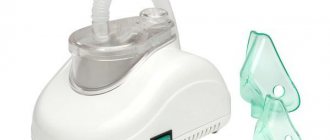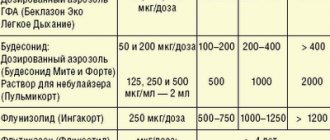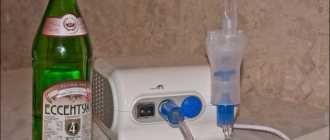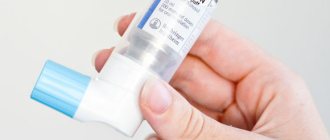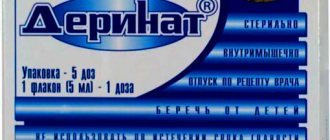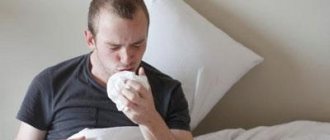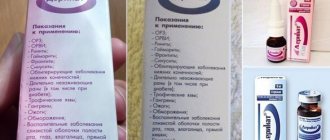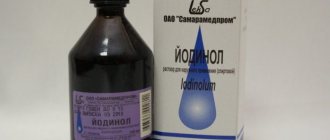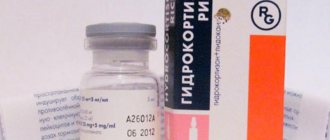Dioxidin for inhalation
This medication belongs to the group of antimicrobials; it is capable of destroying aerobic and anaerobic bacteria. The main active component of Dioxidin is quinoxaline. This is an antibiotic that has a wide range of applications. Pharmacological companies produce Dioxidin in various forms, but for inhalation it is recommended to purchase a solution of Dioxidin in ampoules of 0.5 or 1% concentration.
It should be remembered that Dioxidin is a potent drug. It can negatively affect the activity of the kidneys, adrenal glands and the development of healthy cells. That is why it is strictly not recommended to use this medicine for an inhalation procedure without consulting a doctor.
Information about the drug Dioxidin
The active ingredient of the drug is hydroxymethylquinoxaline dioxide. The active substance itself is a crystalline greenish-yellow powder that does not have any distinct odor. Dioxidin is sold in the form of a transparent light yellow with a greenish tint solution in ampoules, as well as in the form of an ointment. The drug is an antibacterial agent, a powerful toxic antiseptic. Dioxidin combines well with other antibacterial agents belonging to other pharmacological groups; it is possible to combine the drug with substances such as aminoglycosides, beta-lactams, fluoroquinolones and vancomycin.
The active substance selectively acts on the formation of DNA of microorganisms in cells and leads to disruption of their development. As a result, there is a stop in the development of the bacterial population and the onset of recovery. There are no instructions for dioxidine for inhalation as such, so you should consult your doctor about the specifics of its use.
Indications for use
Dioxidin for inhalation is used mainly in severe cases of the disease, when therapy with other drugs has not given the expected effect. Let's take a closer look at what health problems Dioxidin will give a positive result:
- pleural empyema;
- lung abscess;
- pleurisy, which is inflammatory in nature and has a purulent etiology;
- infectious diseases of the bronchi, during which accumulation of exudate occurs.
Description and release form of the drug
The main active ingredient of the drug is considered to be hydroxymethylquinoxaline dioxide. Thanks to this, Dioxidin can rightfully be called a strong antibacterial drug and, at the same time, a powerful antiseptic. The drug is today used to treat bacterial infections.
Inhalations with dioxidine in a nebulizer can have a powerful destructive effect on the following pathogenic microorganisms:
- anaerobic species of bacteria,
- salmonella,
- staphylococcus,
- aerobic bacteria,
- streptococcus,
- Proteus.
Inhalations with Dioxidine for children and adults are used due to the presence in this medication of the main component, which, if the procedure is carried out correctly, cleanses the lung cavity from pathogenic microorganisms. The main substance looks like a crystallized yellow-green powder that does not have any odor.
Proper use of the medicine helps to get rid of the symptoms of the disease and eliminate the cause of its occurrence. Therefore, the procedure must be done strictly according to the instructions, which will avoid unpleasant consequences and side effects.
Contraindications
A potent drug has contraindications for use for inhalation. Let's take a closer look at them.
- Children's age up to 12 years. However, doctors still prescribe the drug to children after 2 years of age. In this case, parents should find out what are the good reasons for prescribing Dioxidin to a child. And the pediatrician must specifically explain the specifics of using the drug for young children.
- Women who are pregnant or breastfeeding are strictly not allowed to use this medication. This is due to the fact that scientists have identified the toxic and mutagenic effects of the drug on the embryo. The medicine also penetrates through mother's milk into the baby's body.
Contraindications to the use of dioxidine
The instructions for use of the solution indicate the possibility of using the product after the age of 12 years. However, in the form of inhalations for inflammatory processes of the respiratory system, dioxidin is prescribed for children from the age of two.
Absolute contraindications are:
- In women during pregnancy and breastfeeding: the antibacterial agent negatively affects the development of the unborn baby;
- In case of individual intolerance to the drug or auxiliary components;
- In the presence of convulsive syndrome.
Side effects
Although Dioxidin is highly effective, the drug can provoke the development of unwanted side effects.
- Toxic and mutagenic reactions (cause various developmental defects in the unborn baby).
- Bronchospasm, convulsive manifestations.
- An allergy that develops due to the presence of quinoxaline in the drug.
- Disorders of the gastrointestinal tract, manifested by diarrhea, nausea and vomiting.
- The drug Dioxidin is excreted from the body by the kidneys, and therefore, if it accumulates or overdoses, violent reactions may occur, expressed by severe headaches and a sharp increase in temperature.
- The occurrence of photosensitivity, i.e. the appearance of pigmented areas on the skin, which disappear after discontinuation of the drug and the use of antiallergic drugs.
It is important to know: if the above side effects occur during treatment with Dioxidin, you should immediately seek medical help.
Contraindications and side effects
- Hypersensitivity to the components of the drug;
- Kidney failure;
- Adrenal insufficiency;
- It is strictly prohibited for pregnant women and nursing mothers, because it damages the fetus and causes gene mutations.
Adverse reactions are mainly observed when Dioxidin is administered directly into the cavity and during parenteral administration. The following may appear:
- Shiver;
- Headache;
- Allergic reaction;
- The temperature may rise to subfebrile (37.1-38) or fibrile (38.1-39);
- Nausea, diarrhea, vomiting;
- Cramps.
If side effects occur, antiallergic treatment is prescribed, which includes antihistamines. It is mandatory to discontinue the use of the drug.
- with allergies or individual intolerance to quinoxaline derivatives;
- during pregnancy and lactation;
- with severe decompensated pathology of the liver and kidneys;
- in young children.
Use with caution in patients prone to hypersensitivity reactions and children under 18 years of age. The use of Dioxidin may be accompanied by a number of side effects. Their severity depends on the method of administration of the substance.
When administered intracavitarily, a person may begin to vomit, develop a rash, develop a fever, experience hallucinations, vomiting, convulsions, decreased blood pressure and other symptoms. When applied externally, dermatitis sometimes develops, swelling, rash, itching and other signs of an allergic reaction appear.
Attention
The use of this medicine is sometimes accompanied by the appearance of age spots on the skin. They disappear on their own after discontinuation of the drug.
Inhalation using a nebulizer is an effective method of treating inflammatory diseases of the upper respiratory tract. The use of a nebulizer allows you to break the liquid into small dispersed particles, which, during inhalation, enter the upper respiratory tract, settling evenly over the entire surface of the mucous membrane. Compared to conventional irrigation of the mucous membrane or rinsing, the effectiveness of treatment increases several times.
- acute and chronic sinusitis;
- purulent sore throat;
- purulent complications of pharyngitis, laryngitis;
- purulent rhinitis.
It is also used to treat complications of burn lesions of the upper respiratory tract, treatment of purulent wounds, phlegmon in the nasal cavity, mouth and pharynx.
Contraindications include:
- individual sensitivity to the drug;
- bronchial asthma;
- adrenal insufficiency (past or active);
- pregnancy;
- lactation;
- cardiopulmonary failure, pneumothorax.
Dioxidin is not used for severe cough with signs of blood in the sputum, or for mechanical damage to the mucous membrane.
- age under 12 years, although if necessary it can be prescribed for children from 2 years of age;
- pregnancy and lactation;
- pathologies of the kidneys and adrenal glands;
- individual intolerance to the components of the drug;
- predisposition to allergies in the form of bronchial spasms.
If the dosage and duration of the course of use of Dioxidin are not observed, the following side effects may develop:
- the appearance of dry mouth;
- headache;
- dizziness;
- temperature rise to 37.6 degrees;
- disturbances in the gastrointestinal tract, which are accompanied by vomiting, diarrhea and nausea;
- chills;
- spasms of the lower extremities.
We suggest you read: How to determine lactose intolerance in a baby - Allergy
It is strictly forbidden for pregnant or breastfeeding women to use Dioxidin. This drug can have a mutational effect on the fetus during gestation. The active substance accumulates in breast milk and leads to poisoning of the baby. The instructions for the drug indicate that its use is prohibited for children under 12 years of age, however, in pediatric practice the drug is used even before this period.
- increased body temperature;
- chills;
- headache;
- pathological processes of the kidneys and liver;
- intolerance to the active substance;
- convulsions;
- allergic reactions;
- age over 60 years.
If an allergic reaction develops rapidly, the inhalation procedure is stopped. It is necessary to sit or lay the patient in a comfortable position, open the windows and ventilate the room. The victim should be given antihistamines in tablet form as a matter of urgency. If the mucous membranes of the throat are swollen, the drugs are administered intramuscularly or intravenously. If you suspect anaphylactic shock, you should call an ambulance.
Instructions for use of Dioxidin in ampoules for inhalation
In order for the therapy to give the desired result, you should follow the instructions for use of Dioxidin.
- The physiological solution used to dilute Dioxidin must be at room temperature. If necessary, you can warm it up by holding a container of liquid in hot water. It is not allowed to overheat or cool below 20 degrees the already diluted product.
- For one session, the duration of which should not exceed 3 minutes, 3 - 4 ml of diluted Dioxidine will be sufficient. 1 - 2 procedures can be performed per day.
- The prepared solution can be stored for up to 12 hours in the refrigerator.
- The best results are achieved by using a nebulizer, but steam inhalers can also be used.
- If the instructions for storage, dilution and dosage of Dioxidin are not followed, it can accumulate in the blood and lymph. And this causes toxic poisoning.
Steam inhalations
If the patient does not have a fever, then steam inhalations will be useful for the disease. To know what to make solutions with, you need to consult a doctor. They have virtually no contraindications other than an allergic reaction, but care must be taken with their implementation. To prevent burns to the respiratory tract, the temperature of the drug should not be higher than 80 degrees.
Popular compositions for inhalation:
- Soda solution. 1 tsp. salt is added to a glass of boiling water or alkaline mineral water.
- Inhaling steam over boiled potatoes is beneficial for redness of the throat.
- Ready-made herbal mixtures are available for purchase in pharmacies. They are brewed, infused and used for inhalation.
- Rotokan. Homeopathic remedy made from medicinal herbal extracts. For the procedure, add half a tsp. medications per 1 glass of water (saline).
Oil inhalations are extremely effective for pharyngitis. Popular are herbal infusions, which can be prepared from various anti-inflammatory plants. If you adhere to the rules of manipulation and frequency, recovery occurs after several days. However, the use of systemic medications should not be ignored.
Inhalations for pharyngitis at home should be carried out after consultation with a doctor. When using such methods, you need to be careful, in particular during pregnancy and when performing manipulations on children, since it is possible to burn the mucous membranes due to the increased temperature of the steam.
Inhalation measures to eliminate pharyngitis.
How are inhalations with Dioxidin carried out for children?
To ensure that the procedure does not harm the child, you must strictly follow the instructions.
- Before starting to use Dioxidin, it is necessary to do tests that will show whether the child has individual immunity and sensitivity to the drug.
- Before starting treatment with Dioxidin, the doctor must make sure that weaker antiseptics do not cope with the problem.
- The use of the drug for inhalation using a nebulizer for children may be justified in case of a runny nose with copious discharge and in case of inflammatory processes in the upper respiratory tract, which are provoked by bactericidal infections. For viral infections, use is not advisable, since the drug has no effect on viruses.
- The solution for the procedure should be warm (approximately 20 degrees), but in no case cold or hot.
- During inhalation, the most important thing is to comply with the dosage and duration of the procedure. For children 2 - 6 years old, the duration of inhalation is no more than 60 seconds, for children 6 - 12 years old - no more than 120 seconds. The procedure can be carried out 1 to 2 times a day, the time interval between inhalations should be at least 12 hours.
- Between procedures, you should carefully monitor the child’s behavior and well-being. If any unusual symptoms appear (for example, increased salivation or swelling begins to develop), you should immediately seek medical help.
- Use by children under 2 years of age is strictly prohibited, as a serious burn of the nasopharynx may develop, which will additionally provoke swelling and pain.
Inhalation therapy
Inhalations using Dioxidin for adults are often carried out only when other medications are ineffective. This is due to the fact that the drug is a very strong antiseptic.
Inhalations using Dioxidin should be carried out correctly as follows:
- Inhalation procedures begin with diluting the medication.
- The therapy process should initially take 2-3 minutes. Subsequently, it can be extended to 5-7 minutes.
- Inhalations for a runny nose and nasal congestion should be carried out through it. If the patient suffers from a sore throat, cough and sore throat, the procedure is performed through the mouth.
- You should not eat or drink for one hour after treatment.
- The procedure is most often prescribed by doctors to be performed once a day. The full course for various diseases is carried out over 6-7 days.
You should definitely ask your pediatrician about whether it is possible to inhale a drug such as Dioxidin for a child. In most cases, such treatment is not recommended for children under 2 years of age. Inhalations are given to older children only after a complete examination.
Important! The dosage of the drug depends on the age of the child, as well as his body weight. Inhalations with Dioxidin are prescribed to children for sinusitis, coughs and colds. If a child does not respond well to therapy, it should be discontinued immediately. The adverse consequences in this case will pass fairly quickly.
Before inhaling your baby, dilute Dioxidin very thoroughly. Often they use a 0.05 percent solution mixed with 4 ml of saline solution. Other proportions of the solution may cause side effects in the child.
Important! Children should not use Dioxidin for inhalation if they have any allergic reaction or individual intolerance. In this case, other means are needed to fight a cold.
Separately, it is worth noting that inhalations with Hydrocortisone and Dioxidine can be carried out simultaneously. To do this, the first drug is taken in a volume of 0.5 ml. You can also use solutions of Dimexide and Hindiox.
Similar articles
Inhalations with interferon for children - instructions
Ingamist for inhalation
Nebufluzone for inhalation
Inhalations with Ambrohexal are an effective cough remedy
( 1 ratings, average: 5.00 out of 5)
Inhaler b well wn 117
Previous article
Children's inhalers and nebulizers
Next article
Advertisements
How to prepare Dioxidin for inhalation
To carry out the inhalation procedure, 0.5% and 1% of the drug is used, which is sold in ampoules. The medicine is diluted with saline solution, which is the basis of the mixture. If the drug has a 1% concentration, then the ratio will be as follows: 1 part Dioxidin and 4 parts saline solution. At 0.5% concentration: 1 part medicine and 2 parts saline solution.
For one inhalation procedure for coughing, 3 to 4 ml of the resulting liquid is used. The maximum dose per day is 8 ml. It is very important to follow the instructions and not exceed the dosage. This will help you quickly obtain a therapeutic effect and avoid the threat of toxic poisoning, kidney damage and other undesirable consequences.
Features of treatment with Dioxidin
Dioxidin for inhalation with a nebulizer is prescribed only in the most extreme, severe cases of illness. Even experienced specialists use this drug only when all other antibiotics and medical procedures have failed. Only after making sure of this can the doctor prescribe Dioxidin. In most cases, it quickly and effectively copes with bacterial infections, pulmonary diseases, purulent inflammatory pleurisy, inflammation of the bronchi and maxillary sinuses with accumulation of mucus.
However, there are times when Dioxidin does not have the desired effect. This is explained by the instability and unpredictability of the complex chemical composition of the drug. At the first sign of ineffectiveness of treatment, the doctor changes the technique and prescribes another drug.
The average cost of a package of 1% Dioxidin solution (10 ampoules of 10 ml each) is about 450 rubles. This amount is most often sufficient for treatment. But sometimes 2 packs may be required.
If you have been prescribed Dioxidin solution, then under no circumstances violate the doctor’s recommendations regarding the dosage and procedure for using the drug. Such a medicine can only take place in extreme cases, when milder and safer means are not able to have a sufficient effect. This most often occurs in cases of advanced diseases. To avoid such aggressive treatment measures, it is necessary to treat the disease immediately, and with the help of a professional. Remember that the sooner you contact a specialist, the cheaper and easier it will be for you to be cured.
Dioxidin (with the active ingredient hydroxymethylquinoxaline dioxide) is one of the most popular disinfectants and antimicrobial drugs in pharmacies. It has been used in medical practice since 1976, available in 5 or 10 ml bottles containing a solution in concentrations of 0.5 and 1%, and in the form of a 5% ointment of 30, 25, 50 or 100 g.
It is used for intravenous injection, as well as for intracavitary administration and local use (treatment of wounds, burn surfaces). For bronchitis of a bacterial nature, runny nose, laryngitis and sinusitis, an ENT doctor may recommend Dioxidin for inhalation with a nebulizer.
Studies of dioxidin, which lasted fifteen long years, showed that this drug, which belongs to the group of antibiotics, is effective against various pathogenic microorganisms:
- Proteus vulgaris;
- Friedlander sticks;
- Pseudomonas aeruginosa;
- coli;
- pathogenic anaerobes (Clostridium perfringens);
- shigella dysentery;
- Shigella Boyd's;
- Shigella Flexnera;
- shigella sonne;
- salmonella;
- staphylococci;
- streptococci.
The action of dioxidin is based on the selective inhibition of the formation of deoxyribonucleic acid (DNA) in bacterial cells, which has a destructive effect on the cell membranes of pathogenic microorganisms.
Indications for use
Dioxidin is prescribed in therapy, surgery, urology, gynecology and dentistry for the following diseases:
- burns;
- sinusitis;
- rhinitis;
- pulmonary abscess;
- brain abscess;
- skin abscess;
- cystitis;
- accumulation of pus in body cavities (empyema);
- purulent pleurisy;
- peritonitis;
- secondary purulent meningitis;
- ulcers;
- purulent mastitis;
- sepsis;
- deep and superficial post-traumatic wounds;
- pustules on the skin;
- inflamed wounds with osteomyelitis.
Dioxidine is administered intravenously only in a hospital setting, in case of severe infectious infection of the body or in the absence of the effect of other antibacterial medications.
Dioxidin for inhalation with a nebulizer in case of a bacterial infection can effectively disinfect the sinuses and throat and speed up recovery.
Contraindications
Since Dioxidin is a potent antibiotic and, according to various studies, has teratogenic, embryotoxic and mutagenic effects, it should be used with great caution and only on the recommendation of a medical professional. The use of Dioxidin for inhalation by nebulizer, locally and intravenously in pregnant and breastfeeding women, in children under 12 years of age, in persons with impaired adrenal function and in case of an individual allergic reaction to the drug is prohibited.
Use with caution to treat patients with renal failure.
Of the side effects after using dioxidine, some patients noted:
- headache;
- convulsive muscle twitching;
- nausea;
- chills;
- diarrhea;
- hyperthermia;
- vomiting
Typically, such reactions occur immediately after dioxidine enters the nasal cavity during inhalation.
Possible side effects
If the patient experiences side effects from the drug, he is prohibited from continuing treatment. These include:
- nausea and occasional vomiting,
- decrease in blood pressure level,
- increase in temperature,
- development of seizures,
- chills,
- temporal pain,
- hyperthermia,
- diarrhea.
Such side effects, as a rule, make themselves felt soon after dexamethasone enters the nose immediately during inhalation.
Drug overdose
Officially, children are allowed to use the drug as an inhalation for a runny nose from the age of 12, but doctors still often prescribe it from the age of 2. After the doctor’s recommendations, ask why your child is prescribed such a serious medication? Make sure your doctor does tests and tests.
The drug is prohibited for pregnant women. The components can adversely affect the development of the fetus, cause missed abortion, and even cause miscarriage in the early stages. In addition, the drug can penetrate the DNA of the fetus and provoke its abnormal development.
What symptoms to expect if a child overdoses with dioxidine? Let's list the main ones:
- headache;
- chills;
- dizziness;
- increased salivation;
- digestive system disorder;
- weakness;
- fainting;
- nausea.
Any of the symptoms should alert parents. After the manifestation of one or more in a complex, we recommend contacting service 03.
Where to buy the drug
You can buy the drug at any nearest pharmacy in your city. We do not recommend buying dioxidin from your hands, since the shelf life of the drug is short. The opened box should be stored in the refrigerator for no more than 1 year. It is better to throw away an open ampoule, but not completely used.
You should not buy drugs from dubious distributors through the local network. By purchasing dioxidine online, you are participating in a kind of lottery with your child’s health at stake! The price of dioxidine in large pharmacy chains starts from 170 rubles. The package contains instructions for use, but there is no information about inhalations.
Remember, any drug should not be used on your own initiative. Only a specialist doctor will select the correct dosage individually for your child; his instructions are correct. Do not harm your child by reading advice on dubious medical forums. Health to you and your children!
Features of application
Treatment with this drug is prescribed only if other groups of drugs have not had a therapeutic effect. This is due to the fact that the medicine has a strong antiseptic effect.
For adults
Dilution of the drug in patients of different ages is no different. The doctor prescribes the same concentration of the drug, which can destroy bacterial microflora. Before starting therapy, it is necessary to undergo tests, since the medication can only have a detrimental effect on bacteria. But viruses and fungi are destroyed by other, no less effective medications.
Kids
To ensure that the procedure does not have a negative effect on the baby’s condition, the solution must be prepared strictly according to the instructions. Pregnant women are prohibited from inhalation.
Before starting treatment, it is necessary to carry out tests, thanks to which it will be possible to understand whether the patient has immunity and high sensitivity to the drug. The doctor must also make sure that other antibacterial drugs have not been able to provide a full therapeutic effect.
If, simultaneously with treatment, the baby experiences side effects, the use of inhalations must be stopped immediately.
Children under 2 years of age are prohibited from using nasal inhalations, as they can cause severe burns to the mucous membranes. This can result in pain and severe swelling.
During pregnancy
While carrying a baby, inhalation treatment is prohibited, as they can lead to toxic damage to the fetus.
